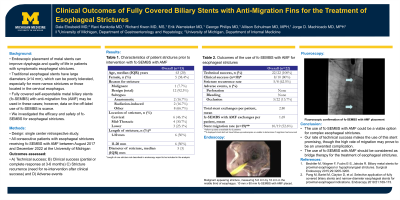Monday Poster Session
Category: Interventional Endoscopy
P2287 - Clinical Outcomes of Fully Covered Biliary Stents With Anti-Migration Fins for the Treatment of Esophageal Strictures
Monday, October 23, 2023
10:30 AM - 4:15 PM PT
Location: Exhibit Hall

Has Audio
- DE
Dala Eloubeidi, MD
University of Michigan
Ann Arbor, MI
Presenting Author(s)
Dala Eloubeidi, MD, Ravi J. Kankotia, MD, Richard Kwon, MD, MS, Erik Wamsteker, MD, George Philips, MD, Alison Schulman, MD, MPH, Jorge D. Machicado, MD, PhD
University of Michigan, Ann Arbor, MI
Introduction: Endoscopic placement of metal stents can improve dysphagia and quality of life in patients with symptomatic esophageal strictures. Traditional esophageal stents have large diameters (≥14 mm), which can be poorly tolerated when the stricture is very narrow or located in the cervical esophagus. Fully covered self-expandable metal biliary stents (fc-SEMBS) with anti-migration fins (AMF) have anecdotally been used to reduce these issues. However, data on the off-label use of fc-SEMBS is scarce. Therefore, we aimed to assess the efficacy and safety of fc-SEMBS for esophageal strictures.
Methods: We designed a single center retrospective study. We identified all consecutive patients with esophageal strictures receiving fc-SEMBS with AMF between August 2017 and December 2022 at a tertiary care hospital. We evaluated the following outcomes: A) Technical success; B) Clinical success; C) Stricture recurrence; and D) Adverse events. Clinical success was categorized as partial or complete response based on endoscopic stricture resolution at 3 to 6 months. We defined stricture recurrence as need for re-interventions after clinical success.
Results: Thirteen patients with esophageal strictures (61.5% males, median age 63 years [IQR 20]) underwent fc-SEMBS with AMF during the study period. Most strictures were benign (85%), severe (median diameter 5 mm [IQR 3]), refractory to ≥3 dilations (50%), and located in the cervical esophagus (46.1%). Most patients (53.8%) had fc-SEMBS as bridging before placing a larger diameter stent. A total of 22 fc-SEMBS were deployed in the cohort, of which technical success was 100%. Clinical success was 80% (8/10 patients), including 2/10 with complete stricture resolution at 3-6 months, both of whom had stent upsizing. Of those who had clinical success, 62.5% (5/8) had stricture recurrence during follow-up. Data on clinical success was missing in 3/13 patients. Of the deployed stents, 52.6% migrated despite AMF, 13.7% became occluded, and 4.5% caused mucosal trauma that led to removal. Two stents were anchored with clips and still migrated, while none was sutured in place. There was no reported perforation or bleeding.
Discussion: Endoscopic placement of fc-SEMBS with AMF is a feasible treatment modality for complex esophageal strictures, especially when used as a gradual bridge towards a larger diameter esophageal stent. However, the rate of stent migration and occlusion may be higher than traditional esophageal stents.
Disclosures:
Dala Eloubeidi, MD, Ravi J. Kankotia, MD, Richard Kwon, MD, MS, Erik Wamsteker, MD, George Philips, MD, Alison Schulman, MD, MPH, Jorge D. Machicado, MD, PhD. P2287 - Clinical Outcomes of Fully Covered Biliary Stents With Anti-Migration Fins for the Treatment of Esophageal Strictures, ACG 2023 Annual Scientific Meeting Abstracts. Vancouver, BC, Canada: American College of Gastroenterology.
University of Michigan, Ann Arbor, MI
Introduction: Endoscopic placement of metal stents can improve dysphagia and quality of life in patients with symptomatic esophageal strictures. Traditional esophageal stents have large diameters (≥14 mm), which can be poorly tolerated when the stricture is very narrow or located in the cervical esophagus. Fully covered self-expandable metal biliary stents (fc-SEMBS) with anti-migration fins (AMF) have anecdotally been used to reduce these issues. However, data on the off-label use of fc-SEMBS is scarce. Therefore, we aimed to assess the efficacy and safety of fc-SEMBS for esophageal strictures.
Methods: We designed a single center retrospective study. We identified all consecutive patients with esophageal strictures receiving fc-SEMBS with AMF between August 2017 and December 2022 at a tertiary care hospital. We evaluated the following outcomes: A) Technical success; B) Clinical success; C) Stricture recurrence; and D) Adverse events. Clinical success was categorized as partial or complete response based on endoscopic stricture resolution at 3 to 6 months. We defined stricture recurrence as need for re-interventions after clinical success.
Results: Thirteen patients with esophageal strictures (61.5% males, median age 63 years [IQR 20]) underwent fc-SEMBS with AMF during the study period. Most strictures were benign (85%), severe (median diameter 5 mm [IQR 3]), refractory to ≥3 dilations (50%), and located in the cervical esophagus (46.1%). Most patients (53.8%) had fc-SEMBS as bridging before placing a larger diameter stent. A total of 22 fc-SEMBS were deployed in the cohort, of which technical success was 100%. Clinical success was 80% (8/10 patients), including 2/10 with complete stricture resolution at 3-6 months, both of whom had stent upsizing. Of those who had clinical success, 62.5% (5/8) had stricture recurrence during follow-up. Data on clinical success was missing in 3/13 patients. Of the deployed stents, 52.6% migrated despite AMF, 13.7% became occluded, and 4.5% caused mucosal trauma that led to removal. Two stents were anchored with clips and still migrated, while none was sutured in place. There was no reported perforation or bleeding.
Discussion: Endoscopic placement of fc-SEMBS with AMF is a feasible treatment modality for complex esophageal strictures, especially when used as a gradual bridge towards a larger diameter esophageal stent. However, the rate of stent migration and occlusion may be higher than traditional esophageal stents.
Disclosures:
Dala Eloubeidi indicated no relevant financial relationships.
Ravi Kankotia indicated no relevant financial relationships.
Richard Kwon indicated no relevant financial relationships.
Erik Wamsteker indicated no relevant financial relationships.
George Philips indicated no relevant financial relationships.
Alison Schulman indicated no relevant financial relationships.
Jorge Machicado indicated no relevant financial relationships.
Dala Eloubeidi, MD, Ravi J. Kankotia, MD, Richard Kwon, MD, MS, Erik Wamsteker, MD, George Philips, MD, Alison Schulman, MD, MPH, Jorge D. Machicado, MD, PhD. P2287 - Clinical Outcomes of Fully Covered Biliary Stents With Anti-Migration Fins for the Treatment of Esophageal Strictures, ACG 2023 Annual Scientific Meeting Abstracts. Vancouver, BC, Canada: American College of Gastroenterology.
